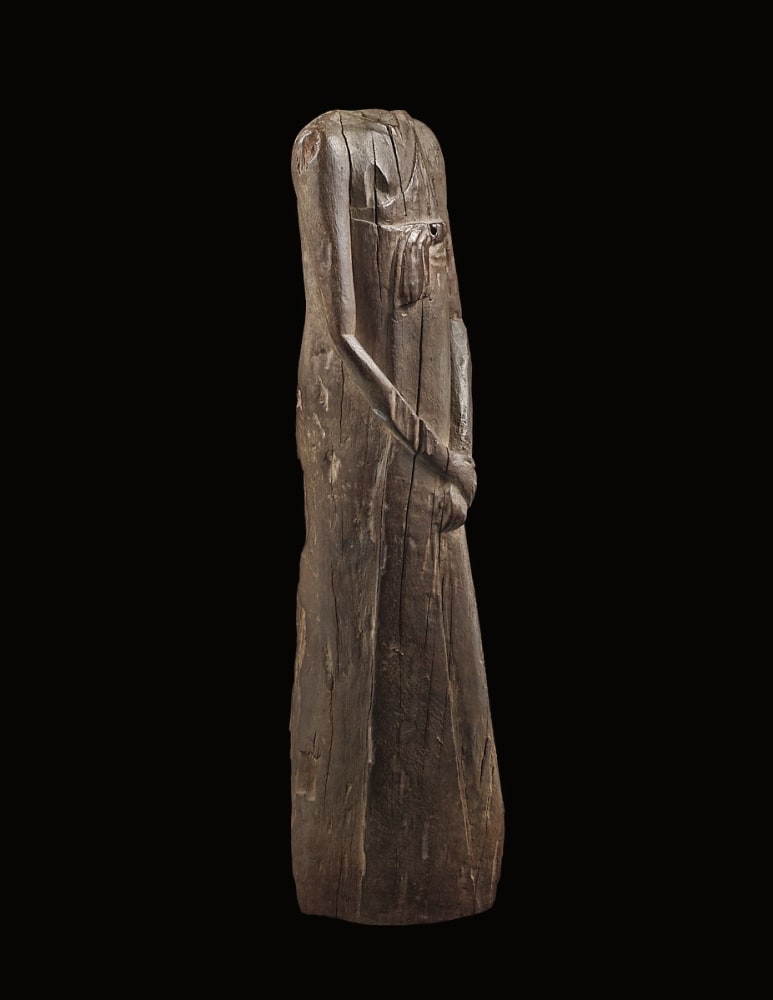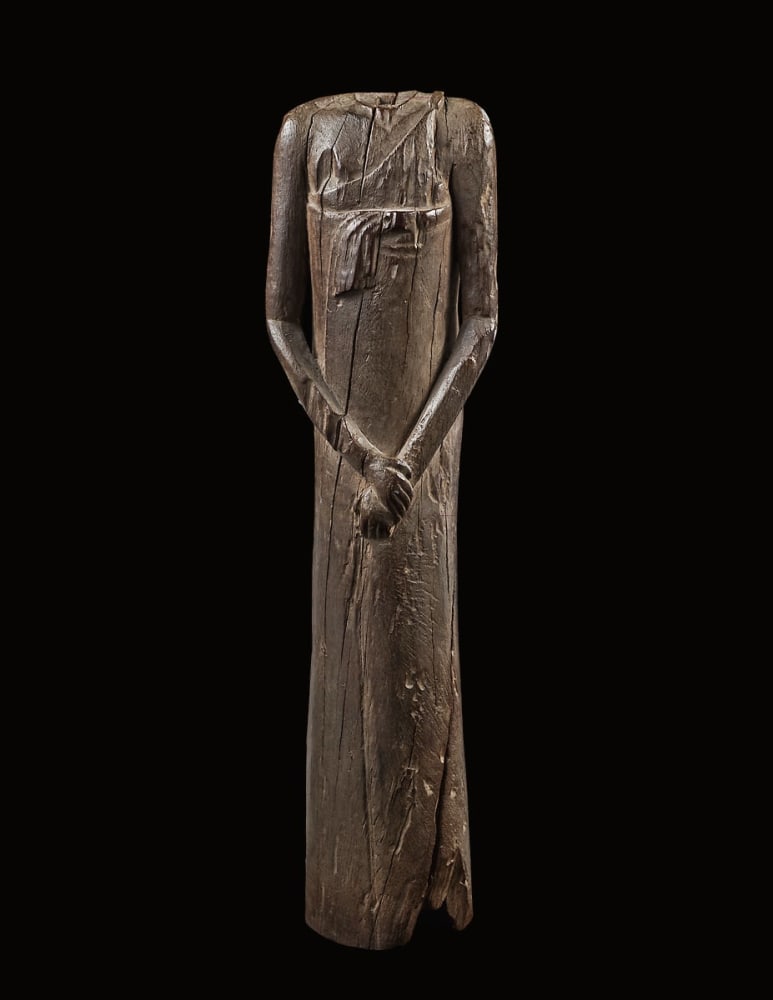Provenance: Jean Larcade Collection, Sold Galerie Charpentier, Paris, 15-16 December 1958, no. 109.
G. Weil Goudchaux Collection, London, 1958-2015.
Published: G. Weil Goudchaux, ‘Une Statuette Pharaonique… Objets’, Revue Semestrielle d’Art et Archeologie, Vol. 2, Geneva, 1969, pp. 10-16. Allard Pierson Museum, Amsterdam, Egypte, Eender En Anders, 1984, Exhibition Catalogue, p. 47, no. 63.
Exhibited: Israel Museum, Jerusalem, 1971-1973 (Loan no. 71.37).
Allard Pierson Museum, Amsterdam, Egypte, Eender En Anders, 1984.
The Egyptian artisan responsible for the creation of this statuette has paid close attention to the remarkable details of an unusual costume, because representations of Egyptian elite male figures are generally shown bare-chested and kilted. The costume is in fact of Persian origin. That Persian costume, as here represented, is a two-piece ensemble consisting of a ‘shirt’ in the form of pleated linen which has been draped asymmetrically over the left shoulder, leaving the right-hand side of the upper torso uncovered. This ‘shirt’ is in turn covered by a long skirt, reaching from the level of the pectoral muscles to the ankles, which has been wrapped around the body and secured in place with a tuck, recalling the way some of us would secure a beach towel around our waist today. The anonymous sitter not only wears a Persian costume but holds his hands in what is termed the Persian gesture, in which the right hand is placed over and clasps the wrist of the left hand.
This gesture is best known from the reliefs of the palace complex at Persepolis known as the Apadana in south-western Iran, founded by Darius the Great around 518 BC and completed a century later, and became the seat of power of the Achaemenian kings. It was looted and burned by Alexander the Great in 331-330 BC after his epic victories at Granicus, Issus, and Guagamela. The palace was excavated by Ernst Herzfeld (1931 to 1934) and Erich Schmidt (1934 to 1939) under the auspices of the Oriental Institute of the University of Chicago. The costume in question, commonly referred to as a kandys or ‘Persian robe’, is popular in Achaemenid court art, and a well-known example depicts a seated Darius I on the original central panel of the North Stair of the Apadana.
Our figure is art historically significant. It demonstrates that the ancient Egyptian artisans could convincingly replicate in their traditional media the fashion and idiosyncratic gestures of different cultures with whom they had contact. The treatment of the pleats of the ‘shirt’ as well as of the folds of the tuck of the long wrap-around skirt reveal the abilities of those same craftsmen in recreating details which lend a degree of verisimilitude to their replications of foreign elements. In this particular case, there is good reason to think that the figure actually represents a Persian dignitary.
The figure was produced during the so-called Second Persian Period (343-332 BC), an interregnum between the defeat and flight of Nectanebo II, the last native Egyptian pharaoh, and the conquest of the Nile kingdom by Alexander the Great. During this period Artaxerxes III, Arses, and Darius III ruled as the pharaohs of Egypt, presiding over the thirty-first dynasty, whilst holding sway over a vast empire that also included Libya, Syro-Palestine, and extending from eastern Thrace to Afghanistan and Pakistan.
Persian costume, guise, and style are found more readily on Egyptian stone figures and reliefs. An earlier figure of the twenty-seventh dynasty of the First Persian Period (circa 450 BC) is displayed in the Walters Art Gallery in Baltimore (Inv. 22.208). This is carved in light green schist and represents an anonymous male in an unmistakably Persian gesture, originally in a striding attitude, with his right hand clasped over his left fist. Another example was excavated in the city of Memphis by Flinders Petrie in the early twentieth century. This depicts Tha-Aset-Imu, in painted limestone, a royal secretary of the thirtieth dynasty of the same period (circa 378-360 BC), and now belongs to the Brooklyn Museum in New York (Inv. 56.152). The subject has a shaven head and is dressed in a sleeved garment with a wide scarf, which covers one arm and shoulder. A third example, carved in dark grey steatite, represents Wesir-Nakht, a kneeling worshipper of the Second Persian Period, thirty-first dynasty (circa 340 BC), contemporary with our wooden figure. This belongs to the Art Institute of Chicago (Inv. 10.243), and has a similar costume. It is also worth mentioning a limestone female figure in high relief in the Brooklyn Museum (Inv. 63.37) in costume of the Persian royal court. This dates to the first or second periods of Achaemenid domination. Collectively, statues and reliefs in Persian guise and style are rare.
Parallels for the present figure are extremely scarce. There are two in public collections in Europe, a third in a museum in Egypt, and the fourth and fifth one in private collections. These five were documented and photographed by Professor Bernard V. Bothmer, who was the first Lila Acheson Wallace Professor of Ancient Egyptian Art at New York University’s Institute of Fine Arts, in his monumental archive, The Corpus of Late Egyptian Sculpture. To date, there is apparently no other statue of this type which has been identified that can be added to Bothmer’s inventory.
For the purposes of identifying the possible role of the present figure in this fascinating period of Egyptian history, the discovery of a limestone funerary stele at Saqqara in 1994 is especially relevant. This was excavated in the necropolis of Memphis by Ian Mathieson of the National Museums of Scotland Saqqara Project. It is decorated with two registers and all the figures represented wear Egyptian costume, with the exception of a seated figure, whose beard is in the Achaemenid style and his costume is identified as the Persian kandys. It sets him apart from the other representations as an Achaemenid dignitary, rather than an Egyptian official dressed in Persian costume, and the excavators of the stele have dated it on stylistic grounds to the First or Second Persian period.
This remarkable statuette also has a long and distinguished pedigree. It first attracted the attention of a wider audience in 1958, when it was sold in Paris to the late Monsieur Guy Weill Goudchaux, after being in the collection of Jean Larcade. The reputation of the late Monsieur Goudchaux as a collector and scholar are well known, and he published the present figure in 1969 (these citations are referenced above). It was subsequently on loan to the Israel Museum, Jerusalem, where it was assigned inventory number 71.37. It was documented and photographed by Professor Bernard V. Bothmer, who was the first Lila Acheson Wallace Professor of Ancient Egyptian Art at New York University’s Institute of Fine Arts, in his archive mentioned above. The statuette later featured in the exhibition ‘Egypte, Eender En Ander’ (and published in the catalogue) held at the Allard Pierson Museum in Amsterdam in 1984.


